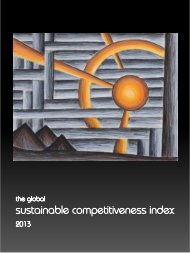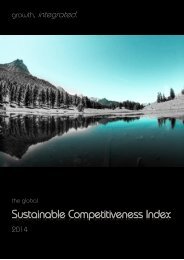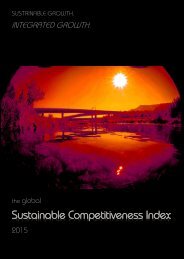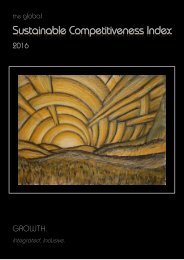The Global Sustainable Competitiveness Index 2019
Measuring competitiveness comprehensively: Sweden & Scandinavia tops, Germany #15, UK 17, US 34, China 37 in the Global Sustainable COmpetitiveness Index 2019
Measuring competitiveness comprehensively:
Sweden & Scandinavia tops, Germany #15, UK 17, US 34, China 37 in the Global Sustainable COmpetitiveness Index 2019
Create successful ePaper yourself
Turn your PDF publications into a flip-book with our unique Google optimized e-Paper software.
Resource Intensity
Table of
Contents
5 Resource Management
The second level of the sustainable competitiveness pyramid is the ability to
manage available resource (natural capital, human capital, financial capital)
efficiently – regardless of whether the capital is scarce or abundant. Whether a
country does or does not possess resources within its boundaries (natural and
other resources), efficiency in using resources – whether domestic or imported -
is a cost factor, affecting the competitiveness and thus wealth of nations. Overexploitation
of existing natural resources also affects the natural capital of the
country, i.e. the ability of a country to support its population and economy with
the required resources into the future.
In addition, non-renewable resources that are used today might be scarce and
expensive tomorrow, affecting competitiveness, wealth and the quality of life in
the future. A number of factors are pointing to rising cost for resources in the
future, in particular natural resources: scarcity and depletion of energy, water,
and mineral resources, increasing consumption (particular in non-OECD
countries), financial speculation on raw materials, and possibly geo-political
influences. The key objective of the resource management category is therefore
to evaluate a country’s ability to deal with rising cost and sustain economic
growth in the face of rising prices in the global commodity markets.
Vital natural resources include water, energy, and raw materials. Most of the
resources used today are non-renewable, or only partly renewable: fossil-based
energy, and minerals. Water aquifers and other natural products (e.g. wood) are
renewable, as long as their capacity is not overused and the replacement
patterns are not drastically altered, e.g. trough depletion, biodiversity loss,
pollution, or climate change.
Key elements of competitiveness
drivers in the Resource
Management Sub-Index
Resource efficiency indicators are evaluated both in terms of intensity (per
capita) and efficiency (relative GDP). The availability of accurate global data is
not as wide as in other criteria, particularly in terms of usage of raw materials.
Other than steel & minerals usage, reliable raw material usage statistics are not
available on a global level. The focus is therefore on energy, energy sources,
water, steel usage, as well as GHG emission intensity and productivity. For the full
list of indicators, refer to the methodology section.
21








